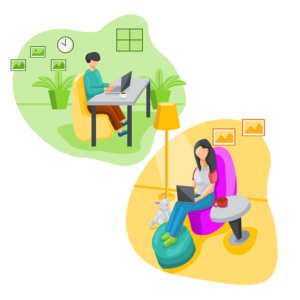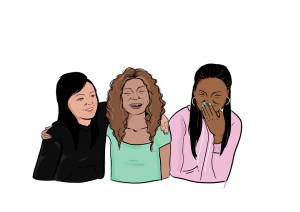
We’ve crossed the finish line of this course. I wish everyone well on wherever the next step is in their learning journey.
Here is my summary of learning:


We’ve crossed the finish line of this course. I wish everyone well on wherever the next step is in their learning journey.
Here is my summary of learning:

This course has been quite the journey. I have never done anything like what I’ve done in this course. I’m happy with my final course profile/prototype because one year ago, or even back in early fall, I’d never have thought that I’d put together an online/blended course with audio recordings, animation, and online discussion using a Learning Management System. I’ve done curriculum, course, and resource development before, but not online/blended design.
I had to teach myself a lot of the technology and tools that I used to put together my course, Indigenous Women: Past and Present. I’d never even heard of Canvas before this course. I’d used Moodle and D2L as part of courses that I’ve either taken or instructed, but I’ve never designed a course within these platforms. The courses that I’ve instructed online had set syllabi, content, and materials.
This project entailed my learning to use Animaker. I chose to use it as a learning tool in my course not only to challenge myself but so that I could include a fun yet applicable learning tool for learners. I thought it fit well for the activity and content. It presents a glimpse into an old story using animation, which is a useful tool to reach a lot of learners in today’s technological world.
I had the initial idea of this course from awhile back, but I had no content for it, so that was also part of my creation process; not to mention. trying to complete all of the textbook and recommended readings so that I could apply theory and principle to my design choices. It was intimidating (and overwhelming), but certainly very useful as it enhanced my skill set and knowledge.
The course is on the LMS, Canvas. It utilizes Canvas features:
My course has changed a bit from what I had initially completed for the first submission. I took some of reviewer feedback and applied some suggestions including the utilization of the Canvas calendar to give a brief look at when the course will begin (January) and how it will run over time (ending with a final project in mid-May or June). I really liked Jacquie’s use of a calendar to layout her course, so I was inspired by her use of a course calendar to organize materials/modules.
You can see the changes (and growth) in my course from our first submission in January to the second submission in February to our final submission this week. I must say, I am feeling overwhelmed and tired. It’s a lot as an older student to be staring at a computer screen while at the same time teaching myself how to use most of these tools. I’m definitely feeling cognitive overload, and experiencing extremely tired eyes.
Here is my initial blog post of my course profile/prototype:
My January 25th Blog Post – Course Profile
Here is my second blog post on the second submission of the course profile/prototype that consists of the two modules. It has a PDF link that provides the overview:
My February 16th Blog Post – IWPP Course Profile and Shell (Two Modules)
Below is my final course profile/prototype and overview in PDF format but it is also available under “Syllabus” on Canvas within my course, Indigenous Women: Past and Present.
Donna Beyer. Final Course Profile Prototype. EC&I 834. docx
Here is a link to my course on Canvas (but I will need to add your email to the course for anyone to access so just comment on blog post with your email and I’ll add it):
Indigenous Women: Past and Present (on Canvas)
Here is a link to my Screencastify of my course:
Screencastify of Indigenous Women: Past and Present on Canvas
Ekosi. Thank you for reading and listening! And I hope that everyone does well on their final course submission.

Photo by minanfotos on Pixabay
I am always ambivalent about mandatory interactions (group work and discussions) for courses. I understand the need for them in terms of learning, but as a learner I’ve never enjoyed group work or discussions, so I try to maintain that awareness as an instructor. Certainly, during high pandemic, many students needed to have a form of socialization for mental health and engagement. That, I completely understand. And many people are extroverts who enjoy (and thrive) on socializing, but there are also many people who are introverts preferring to be on their own and work independently. There are a multitude of reasons for such a preference. There are also other considerations such as social anxiety, mental health issues, learning uniqueness(es), personal situations and safety. By safety, I mean depending on the course (environment) and group of students, it is the teacher or facilitator’s job to ensure that students feel safe in group work/environments. There are attitudes, mindsets, and personality differences that can come into play for group work/environments. And often times, we as employers/teachers/facilitators push for these collaborations because we want “work bullies” to change and learn how to “work together” rather than taking the safety of other employees/students into consideration. In my opinion, it is not the job of other employees/students to educate other staff/students. They may choose to do so, and that’s great, if they choose to do so (not because they’re forced to do so because no one else will), but it is not their role. We can write all the codes of conduct we want, but aggressions will still happen, and often times employees/students will not approach an employer/teacher regarding these, in particular, because they are hard to “prove”. This may correspond to what we read regarding cultural and epistemological considerations in Chapter 4 of the text.
My daughter completed her first year of studies at Concordia University. She dropped a course that required 3-4 breakout rooms per class. It was just too much for her as an introvert – and as someone who has social anxiety. She was willing to do 1, maybe 2, breakout rooms per class, but for her, 3-4 per class was too much during a 1.5 hour class that ran twice a week. She dropped it and never looked back because her stomach would be in knots the day of class as she tried to mentally prepare herself for that class. Indeed, people require the skills of working as a team, communication, and so on, but for my daughter, the amount of interaction required was just too much. Further to this, sure, people with anxiety can overcome anxiety by challenging and pushing themselves, but this usually works best when it is at their own pace. I’ve seen my daughter challenge herself and do very well, but at her discretion. There seems to be a push for group (interactive) work during/since the pandemic, and I understand why, but I really don’t recall doing as much group discussion/work as students are required to do today (way) back when I completed my undergrad and Master’s degree. I recall marks being allocated to class participation and discussion, and the occasional group activity, but not as much as I witness my daughter having to partake in today. (Note: I got my daughter’s permission to blog about her personal experience).
Having said that, I enjoyed the readings Building Community in Online Learning Environments and Building Community in Online Courses as both offer a lot of great ideas in building community for online learning. I’m completing an asynchronous online course that I’m really enjoying. In my opinion, it’s set up for very well. Recently, the professor of this course who checks in with us regularly provided individual feedback for our midterm synthesis via video, which was a nice surprise – and very useful. It was personable and warm. As mentioned in Michael Wesch’s video, it “validated and motivated” my work in that particular course because it provided me with great comments/feedback and offered words of encouragement. And as mentioned in the Andrea Harkins Parrish piece (respect/relationships/relevance), I felt like the professor was connecting, building relationship (addressing students directly in the feedback video), while at the same respecting the choice of us registering in an online (asynchronous) course. This is also mentioned by Wesch when he suggests that teachers personalize videos by addressing students by name, it humanizes the online experience, offers connection and warmth.
Currently, my course prototype has a Parlay discussion for asynchronous student to student interaction. The students are required to answer four questions and they must respond to at least two classmate responses. In my course prototype peer feedback, it was suggested that I use a rubric in the discussion so that students are supported in their responses/interactions in the Parlay activity, so I will be integrating that idea into my final prototype so that students are better supported in that space for writing their responses. I may also include an assessment that falls in line with OCL’s intellectual convergence asking students to submit a type of synthesis assignment that demonstrates what they’ve learned from their peers’ responses. However, they’d do this assignment independently, not in “joint construction of some artefact” (Chapter 4 of course text).
I chose to use only one asynchronous student to student interaction for my prototype because it is a blended course; thus, students will have plenty of in-person synchronous class time together, which will entail opportunity (the option) to work together during class time at a computer completing online work. This, I think, falls in line with the Harkins-Parrish piece in that it offers flexible option for online participation because students who enjoy working online (and independently) may do so, but those who may find this part difficult can complete the online work (with others who feel similarly) in the in-person synchronous classes.
As for the teacher and student (T-S) interactions in my course prototype, these will take place during the in-person synchronous classes; however, I enjoyed some of the ideas shared in the two readings mentioned above as well as in the Michael Wesch video, so I’m considering integrating another form of teacher-student interaction into one of my two modules. I’m just not sure what type would be the most effective to use on the LMS when most T-S interaction will take place in in-person synchronous classes. I’ll have to ponder this one more.

Image by Unsplash, Dawid Zawita
My (draft) course is titled Indigenous Women: Past and present. Storytelling is an important foundational component in the course in its entirety. It is how the course begins because for Omushkego Cree and Anishinaabe peoples oral history has been a part of who we are since Time Immemorial. It is an important part of this course because the target student population is individuals of Indigeous descent who feel disconnected from their Indigeneity, their roots. It is also solely for Indigenous women and Two Spirit individuals, so stories about the significant roles that women held (hold) are critical. One of the course goals is to support students in their journey of reconnection, wherever they may be in that journey. Thus, the parts of the stories that are included at the beginning of the course are required for student prior knowledge and (re)building identity so that as students move through the course they may apply the teachings in those stories to significant work of Indigenous women today.
There are important cultural protocols around storytelling for many First Nations and Indigenous peoples including that many types of stories were (are) to only be told in the winter season. There are many commonalities among First Nations and Indigenous peoples. We are certainly connected. But there are diversities as well, in culture, language, ceremony, spirituality, protocols, and practices. This is also true for storytellers, Elders, philosophers, teachers, knowledge keepers, advisors and more. Dr. Louis Bird is a well-known storyteller, philosopher, Elder, historian and much more, not just in his traditional territory but in many areas. He’s collected the stories around his territory since he was a young man. He never claims to be an expert despite the enormity of his knowledge and experiences. He is also my adopted grandfather. Truly, a blessing.
What Louis taught me is that many Native people have become disconnected from their culture(s), language(s), and spirituality(ies) due to colonialism, and we live in a time that calls for the reclaiming, renewing, and revitalization of our ways, especially for young people. While it is important to maintain traditions, we are also allowed to be fluid and dynamic in a good way. He once said to me and another colleague that ancestors see us. They see the time that we’re living in, its climate, and how colonialism has impacted us and our communities, so they understand what we’re often up against in this new world. And it is for this reason, I approach including these stories in a good way. I also choose not include in my course profile some of the practices that will be a part of the course that supports the sharing of these stories.
Renowned Indigenous educator, Dr. Verna Kirkness talks about the importance of banking our knowledge(s) and language(s). And (Dr.) Louis Bird does this important work as he has written books and created Our Voices, An Omushkego Oral History Project so that current and future Omushkego generations know who they are and where they come from.
Louis Bird also talks about the types of stories that he has collected over his lifetime including what he refers to as Quotation Stories, Legends, Creation Story, Recent Stories, and Mystery (Fantastic) Stories. It is more those that are often referred to as legends that were (are) told in the winter season. Creation Stories are not legends. (I should mention here that while the term legend is used to refer to some stories, it comes with the connotation of being untrue, but this is not the case in First Nations stories, use of the term does not mean that the story isn’t true). Louis uses the term legend for Wisahkaychak, Wihtigo, and Chakapesh (to name a few) stories, but he does not refer to Creation Stories as legend. And Our Grandmothers’ Powers would also not be considered a legend, it would be a quotation story, or a recent story because it is about events that happened not long ago.
Now, I must say that these are the teachings that I was given. It is what I was told and taught, and I am no expert. And I come from a specific territory. This is the context of which and how I approach my work. It does not apply to everyone, and it shouldn’t, so no one should take my words as guideline. Each person doing work in Indigenous Education (Knowledge Systems) must seek out their own teachings because we are all unique in who we are and how we do this work (and how we intend to use it).
As for other aspects in my (draft) course, I will add rubrics to each activity in the modules, which I think will bring on more ideas and feed into some other suggestions that were given in review; however, the rubrics would be more a facilitator guide then for students (participants) because the intention is for them to have more freedom in their understanding, interpretation, and expression particularly in those first two modules. As the course progresses, student demonstration(s) of learning will be a bit more structured as expectation(s) also progress.
I’ve purposely left out part of the Old Nokomis story as this was/is often an element of storytelling so that curiosity is peaked and questions encouraged, but I may rework the Animaker video that I created for this course. I had wanted to push myself out of my own comfort zone when I used Animaker and incorporated it into the course.
Again, this is a blended course, so a lot of content (and protocol) will be covered in an in-person synchronous classroom setting including prior knowledge needed for the online (asynchronous) components of the course. Feedback will happen in the classroom with students (participants) and the timeline for the course may appear short (online), but it is taught in conjunction with the content covered in in-person synchronous classes. One of my reviewers utilized a calendar in their course, so perhaps I will look at whether this, too, could work for my course. I will also re-examine my layout in Canvas (tabs, etc), so that it is visually more appealing and perhaps I will incorporate the word, units, for modules.
I will also add the transcript for one of the stories in the modules. This will provide additional support to learners. This seemed to be an oversight for many courses.
Ekosani reviewers! Your time and feedback is appreciated.
I put my course profile and shell directly into the Learning Management System, Canvas, which is what I used for my course platform. It is in the Syllabus section.
But I thought I should also put it here on my blog for easier access for instructor and reviewer/s, so here it is in PDF format: IWPP Course Design for Online and Blended Learning.
Ekosi.
I chose Padlet for my blog, which encourages reflection and commenting. I just started teaching an online course, so I thought I’d try Padlet with some of my course material that I had asked learners to reflect on including Stories as Pedagogy; What Indigenous Writers, Scholars, and Thinkers say about Indigenous Literature; and, Analyzing Literature.
The course content was ready, so it took me only 22 minutes to input it all (strength) into Padlet using three different kinds of padlets. This means it was easy to use (strength) because I had to teach myself how to navigate Padlet and create a padlet before doing so.
I used three layouts including the Wall layout (places content in a brick-type visual), the Stream layout (places content in an easy to read, top to bottom visual), and a Canvas layout (places content in scatter form); however, the Canvas layout leads you to believe that you create ‘connectors’ between ideas (like a web), but I wasn’t able to figure that out if it does indeed offer that feature (weakness). The other types of padlet formats are Grid, Shelf, Map, and two types of Timelines (which would be great for historical timelines of leaders and/or events). Here is a link to a visual of the types of padlets formats.
For each padlet that you create, there are multiple options and settings to choose from:
Other options for your padlets are privacy options as you can make one or all of your padlets password protected, or completely public (strength). It allows for easy exporting (strength).
I was able to easily insert a Word document into one of my padlets as well as a link to a YouTube video. I am able to easily move around each section of information within the padlet, and it offers the option to play the padlet sections as slideshow for students, which I thought was a cool feature.
It’s seems like a fun tool that all ages (particularly younger learners) would enjoy. The padlets allow for students to comment on sections as well as ‘like’ them, which gives it a social media feel for students. It seems like a tool best served for the social sciences. I liked how easy it was to input my content into each padlet and students can ‘like’ and/or comment inputted content (or comments and conversation, if a padlet is used for that). One can also ‘follow’ a padlet to receive updates on content/material, and I believe that I read it offers the option to ‘unfollow’ if you’re added to a padlet that you do not wish to be a part of (strength if you don’t wish to receive updates; a weakness if it’s a student who does not want class updates).
I didn’t explore Padlet in its entirety, but I liked it. As you can see, I listed strengths more than weaknesses; however, I am fairly new to online learning tools so I don’t have much to compare it to so if you’ve used Padlet and a similar tool that is better, please share!
Ekosi.

Image: Pixabay, Alexandra_Koch
| Course Title | Indigenous Women, Past and Present |
| Course Description | Students will learn about Indigenous Women, past and present. The course will begin by looking at historical roles of Indigenous women and move to important contributions made by Indigenous women today in various landscapes.
The purpose is to deepen identity and celebrate Indigenous women by learning about and connecting to their work and contributions, past and present. The course will move similar to the Community of Inquiry Model (COI) in that facilitator and learners will collaborate and engage in discourse and reflection to construct personal meaning and understanding(s) based on mutual interest. It will consist of:
|
| Target Student Population | This course is designed for a cohort of Indigenous women and Two Spirit individuals enrolled in a program that is similar to Ka-Ni-Kanichihk Inc.’s Honouring Gifts. |
| Course Format | This course will be delivered utilizing Blended Learning that consists of synchronous face-to-face learning with lectures, technology aids, and discussion.
It will use of the learning management system, Canvas, to incorporate course materials and assessments, to be completed asynchronously. |
| Course Toolset and Assessment Strategies | This online component of this course will be delivered using the LMS, Canvas. Asynchronously, learners will complete readings, watch short videos, participate in discussion, and link with various forms of social media as part of course instructional tools. Facilitator will provide online links to films like Buffy (NFB) by the National Film Board that learners can watch and respond to online asynchronously.
Face to-face classroom learning will consist of transmissive lecture style as a means for the facilitator to share and define important key terms and concepts in Indigenous History and Studies. Face-to-face learning will also entail readings, discussion, videos, research exercises, and student-centered learning activities such as writing responses and role play. Formative assessment:
Summative assessment:
Facilitator communication and feedback will be provided both face-to-face and using LMS. Facilitator will limit access to materials (modules) in LMS so that learners may progress as a cohort, but will work those who miss a face-to-face class due to personal/family obligations. |
| Course content | This aim of this course is to provide an introductory survey course to students. It is by no means comprehensive. Students will gain awareness and knowledge of Indigenous women and their contributions, past and present.
Indigenous women have held vital roles in their respective communities since time immemorial and maintain such roles in today’s world. They are artists, activists, filmmakers, doctors, knowledge-keepers, scholars, athletes, politicians, and much more. At the same time, the 2019 National Inquiry into Missing and Murdered Indigenous Women and Girls found that Indigenous females face a greater risk of experiencing violence in today’s society. We will look at some of historical roles of Indigenous women as shared by Elders and Knowledge-Keepers including “Roles of Women” by Louis Bird (Omushkego). We will also look at some contemporary contributions of Indigenous women from various Nations across Turtle Island in areas such as sports, education, science, politics (activism), entrepreneurship, and arts and culture. Learners will look at the work of poet, Pauline Johnson (Tekahionwake, 1800’s), and move to artist, Jackie Traverse (Anishinaabe, current). Online modules will be organized in eras and/or time periods, so that students will learn about women by time period; however, each era will covered face-to-face and online, so that students have an array of learning experiences. |
| Learning Objectives | 1) Discuss diverse historical roles of Indigenous women.
2) List contemporary contributions of Indigenous women in today’s society. 3) Name influential Indigenous women in home Nation (community). 4) Construct a biographical overview of one Indigenous woman. |
| Considerations and Support | This course is designed to be offered in partnership with an in-community learning facility/centre, which generally offers cultural and academic support to all learners including access to Elders, counsellors, and tutors (writing support).
There may be limitations in bandwidth due to this course being offered to communities that may be rural or remote. Most community learning centres offer computer and enhanced internet access to learners, but we will provide laptops and Wi-Fi adapters if and when needed for the duration of the course. Attendance is a consideration for learners in this course as some students may be caregivers with family obligations, so facilitator will offer flexibility in asynchronous online learning materials, tools, and assessments. |
| Rationale | Blended learning will offer learners opportunity to become better independent learners in a digital age, especially for those who may not have much experience with computers and internet (research). It will provide a balance between teacher instruction and computer-based learning giving learners more control over their own learning and hopefully optimizing their experiences with education.
Blended learning also recognizes that not all students learn in the same way or at the same pace, so it provides diverse ways of learning that may potentially meet the interest, and gift(s), of each student. The course will progress similar to Bloom’s Taxonomy of learning, cognitivist learning theory, which entails students moving through levels of learning, from remembering to evaluating and creating knowledge. This process involves three domains of learning: 1) cognitive (thinking) 2) affective (feeling), and 3) psycho-motor (doing). Having said that, Indigenous systems of learning progress in levels as well. Transmissive lecture style will be used as an initial face-to-face teaching method, so that facilitator may share and define important key terms in Indigenous History and Studies, which falls in line with objectivist theory in that it introduces students to concepts using memorization. This will provide foundation to student learning of course content. Most of the assignments (assessment) in this course fall under constructivism theory in that it is believed that learners interpret the external world by assimilating information and relating it to their existing knowledge. They process that knowledge through synchronous face-to-face and asynchronous online discussions, both forms of social interaction, and develop personal meaning through oral and written reflection(s). Facilitator will also utilize short online quizzes as formative assessment, which is more in line with behaviorist (objectivist) theory; however, this useful for receiving and providing immediate feedback for terminology and concepts. Collaborative learning in asynchronous discussion as learners share and plan for their final biography project. They will generate, organize, and converge ideas for this project, which is follows online collaborative theory and the three phases of knowledge construction. Learners will choose and approach two community members; Indigenous women whose work and position they admire, and conduct two short, informal interviews while sharing with them the course content and purpose. Learners will create their own interview questionnaires based on course content, and discuss them with peers for feedback. This learning activity involves experiential learning, which is part of connectivism in that the facilitator provides initial opportunity, but learners are constructing their own network of women they admire and wish to learn more about. They are learning by doing, and will apply the knowledge gained in the course to their interviews. The final biography project is inquiry-based learning in that the facilitator presents course content to all students, but they research and choose the person that they wish to learn more about. They will utilize face-to-face class discussions and asynchronous online discussions to share and plan for their final project. This final project will be shared in-class in a presentation where student will be provided with a guide rubric so that they may provide feedback to their peers. The teaching method, or epistemology, for this course is that of social reform, which seeks change and social justice in society. The hope is that students will be inspired by the roles and work of Indigenous women, past and present, and become active change agents in whichever landscape they choose. |

Image by mohamed_hassen (Pixabay)

Photo by eirabirkhammer on Pixabay
I’ve been an instructor for most post-secondary institutions here in Manitoba since obtaining my Master’s degree back in 2011, but I’ve been away from instructing for the last five years. I return to instructing next week as I’ll be teaching an (all) online course for UCN, which I’m excited about.
When putting together my outline for that course back in November, I took the time to think about and list some student activities that would give them a break from listening to me “talk” at them at about 20 minute intervals. This was before this course started, so it was reassuring to read the questions in Chapter 10: “Who are the students?” “What kind of learners are they?” “What resources do I have to teach content?” and “How will I assess understanding?” I also found it useful to read the sections that discussed transmissive lectures and attention spans, and that most post-secondary instructors may not have background in teaching theory; but this doesn’t mean that they don’t practice the components of that theory (or theories).
I taught one online course back in 2011. I didn’t enjoy that very much despite having the course and (set) content laid out for me. I probably would have enjoyed it more if I was able to choose more of the content and assessment. I don’t like to assign group or discussion work as an instructor because as a learner myself that is not something I particularly enjoy (as an introvert); however, this course had a group wiki project attached to it so I was to oversee (assess) that component. One issue with online group work was that one student was usually doing all of the work, so it was quite difficult to address, especially as a new instructor.
In another professional context, I was a facilitator for teachers (PD), so I’d develop resources and workshops. Again, I didn’t want to “talk” at anyone for hours on end, I wanted it to be interactive, and I wanted to utilize technology, so I used blended learning (technology as an aid). A very simple experience with Blended learning, but I found it very useful for engaging participants. I’d use PPT visuals to assess prior knowledge before beginning a workshop, and participants would later be provided with the ‘answers’ to assess their own knowledge. I found this to be an excellent (and fun) way to start a workshop (session) as it set the tone for our learning.
Having said that, I’ve always tried to make classroom, face-to-face learning fun too. I’d do online scavenger hunts for artists/songs, which post-secondary students really loved, and it (again) seemed to set the tone for their interpretation/analysis of the lyrics later on. They were asked to go online to find an Indigenous artist who wrote and sang a song about the Buffalo. This activity led most students to this song.
Interestingly, what I noticed with that activity was that younger students would help older learners who maybe weren’t as tech/internet savvy. They’d pair up on their own at a computer (there was a lab in the classroom), and they’d have a lot of fun laughing (and learning) together, so even though at that time I had no conscious plan to have them practice skills they’d need in a digital age, they were doing it.
Ekosi.
My name is Donna and I live in Winnipeg. I have a wonderful daughter who is in her second year of studies at the University of Winnipeg and an amazing husband who is the hardest worker that I know. They … Continue reading